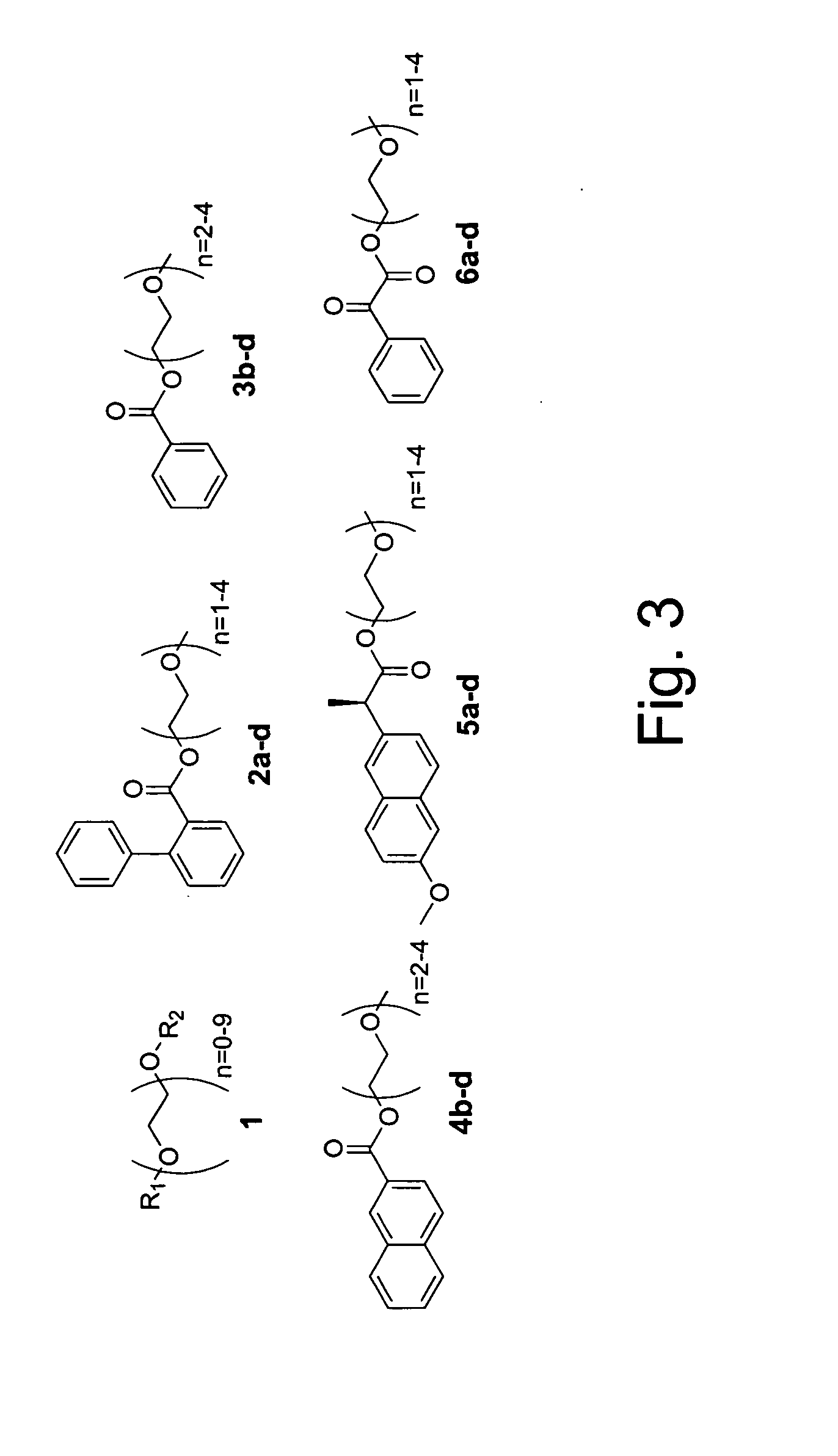Separation of compounds using tagging moieties including varying numbers of repeat units
a technology of repeat units and compounds, applied in separation processes, water/sewage treatment by ion exchange, ion exchangers, etc., can solve the problems of inability to transfer solution phase reactions to solid phase, difficulty in monitoring reaction progress, and difficulty in characterizing products still bound to the support, etc., to achieve greater the polarity of the tagging moiety and the number of repeat units.
- Summary
- Abstract
- Description
- Claims
- Application Information
AI Technical Summary
Benefits of technology
Problems solved by technology
Method used
Image
Examples
experimental example
Example 1
Double demixings of the 16 compound mixture of fluorous and OEG tagged 4-hydroxy-3-methoxybenzoates.
Method 1: One silica flash column followed by four fluorous prep-HPLCs: The mixture was first separated via flash column chromatography on silica gel with gradient eluents (pentane / ethyl acetate 5:1, 3:1, 2:1, 1:1, 1:2 and 1:4) to give four fractions according to the OEG tags (each of the fractions contained four compounds with different fluorous tags). Each of the fractions was then dissolved in 1.5 mL of CH3CN and injected onto a FluoroFlash PF-C8 hplc column (20×250 mm). The column was eluted under a linear gradient conditions. The gradient started with 60% CH3CN / 40% H2O and ended with 100% CH3CN in 30 min. The flow rate was 15 mL / min. The four fractions in each injection with retention time of ˜7 min, ˜12 min, ˜19 min and ˜23 min were collected separately and concentrated to give the sixteen individual compounds respectively.
Method 2. One fluorous prep-HPLC followed...
example 2
Encoded Synthesis and Separation of Sixteen Stereoisomers of Murisolin. Julia olefination and hydrogenation:
A solution of the sulfone M-11 in THF was cooled to −78° C. and NaHMDS was added under argon. The reaction mixture was stirred at −78° C. for 30 min and a solution of the aldehyde M-11 in THF was then transferred in via cannula. The resulting mixture was then warmed to room temperature overnight and H2O was added. The layers were separated and the aqueous layer was further extracted with Et2O (3×20 mL). The combined organic layers were washed with brine, dried over MgSO4 and concentrated under vacuum. The residue was purified by gradient flash chromatography (pentane / ethyl acetate 10:1, 5:1, 2:1 and then pure ethyl acetate) on silica gel to yield the coupling products as four components (as according to the OEG tags).
LCMS (APCI): a m / z: 1159 (M1+1)+, 1176 (M1+H2O)+, 1203 (M2+1)+, 1220 (M2+H2O)+, 1264 (M3+H2O)+, 1308 (M4+H2O)+; b m / z: 1259 (M1+1)+, 1276 (M1+H2O)+, 1303 (M2...
PUM
| Property | Measurement | Unit |
|---|---|---|
| polarity | aaaaa | aaaaa |
| Lewis basic | aaaaa | aaaaa |
| polar | aaaaa | aaaaa |
Abstract
Description
Claims
Application Information
 Login to View More
Login to View More - R&D
- Intellectual Property
- Life Sciences
- Materials
- Tech Scout
- Unparalleled Data Quality
- Higher Quality Content
- 60% Fewer Hallucinations
Browse by: Latest US Patents, China's latest patents, Technical Efficacy Thesaurus, Application Domain, Technology Topic, Popular Technical Reports.
© 2025 PatSnap. All rights reserved.Legal|Privacy policy|Modern Slavery Act Transparency Statement|Sitemap|About US| Contact US: help@patsnap.com



